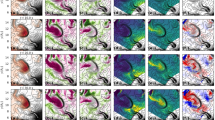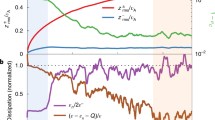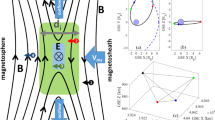Abstract
A wide range of plasma instabilities exist in various regions of the terrestrial ionosphere, leading to the development of plasma turbulence, in particular close to the lower-hybrid frequency—the frequency of a longitudinal oscillation of ions and electrons in a magnetized plasma that must be near perpendicular to the magnetic field. Most observations have been carried out in the auroral regions, where intense lower-hybrid emissions are frequently observed, possibly producing solitary structures1 and ion heating2,3,4. Lower-hybrid turbulence with a smaller intensity has also been observed at mid- and low latitudes above thunderstorms5,6 and was shown to be triggered by the electromagnetic whistler wave generated by the lightning current. Here we present observations of equatorial plasma waves that demonstrate the existence of lower-hybrid solitary structures and the simultaneous occurrence of ion heating in deep, large-scale equatorial plasma depletions that form at night during disturbed geomagnetic conditions. These phenomena follow the development of lower-hybrid turbulence triggered by lightning-induced whistlers, revealing a new coupling process between the troposphere and the ionosphere. Since the energy source of the equatorial solitary structures is different from that involved in the auroral processes, our findings support the idea that the formation of lower-hybrid solitary structures may be a universal mechanism operating in inhomogeneous, magnetized plasma and possibly leading to ion heating and acceleration.
This is a preview of subscription content, access via your institution
Access options
Subscribe to this journal
Receive 12 print issues and online access
$259.00 per year
only $21.58 per issue
Buy this article
- Purchase on Springer Link
- Instant access to full article PDF
Prices may be subject to local taxes which are calculated during checkout




Similar content being viewed by others
References
Schuck, P. W., Bonnell, J. W. & Kintner, P. A review of lower hybrid solitary structures. IEEE Trans. Plasma Sci. 31, 1125–1176 (2003).
Retterer, J. M., Chang, T. & Jasperse, J. R. Ion acceleration by lower hybrid waves in the suprauroral region. J. Geophys. Res. 91, 1609–1618 (1986).
Retterer, J. M., Chang, T. & Jasperse, J. R. Transversely accelerated ions in the topside ionosphere. J. Geophys. Res. 99, 13189–13201 (1994).
Lynch, K. A. et al. Auroral ion acceleration from lower hybrid solitary structures: A summary of sounding rocket observations. J. Geophys. Res. 104, 28515–28534 (1999).
Kelley, M. C., Ding, J. G. & Holzworth, R. H. Intense ionospheric electric field and magnetic field pulses generated by lightning. Geophys. Res. Lett. 17, 2221–2224 (1990).
Baker, S. D. et al. Generation of electrostatic emissions by lightning-induced whistler-mode radiation above thunderstorms. J. Atmos. Sol.-Terr. Phys. 62, 1393–1404 (2000).
Kelley, M. C. The Earth’s Ionosphere (Academic, San Diego, 1989).
De La Beaujardière, O. et al. C/NOFS: A mission to forecast scintillations. J. Atmos. Sol.-Terr. Phys. 66, 1573–1591 (2004).
Rasmussen, C. E. & Greenspan, M. E. Plasma transport in the equatorial ionosphere during the great magnetic storm of march 1989. J. Geophys. Res. 98, 285–292 (1993).
Su, S.-Y., Yeh, H. C., Chao, C. K. & Heelis, R. A. Observation of a large density dropout acroos the magnetic field at 600 km altitude during the 6–7 April 2000 magnetic storm. J. Geophys. Res. 107, 1404 (2002).
Basu, S. et al. Near-simultaneous plasma structuring in the midlatitude and equatorial ionosphere during magnetic superstorms. Geophys. Res. Lett. 32, L12S05 (2005).
Singh, S., Bamgboye, D. K., McClure, J. P. & Johnson, F. S. Morphology of equatorial plasma bubbles. J. Geophys. Res. 102, 20019–20029 (1997).
Berthelier, J. J. et al. IAP, the thermal plasma analyzer on DEMETER. Planet. Space Sci. 54, 487–501 (2006).
Lebreton, J. P. et al. The ISL Langmuir probe experiment processing onboard DEMETER: Scientific objectives, description and first results. Planet. Space Sci. 54, 472–486 (2006).
Berthelier, J. J. et al. ICE, the electric field experiment on DEMETER. Planet. Space Sci. 54, 456–471 (2006).
Parrot, M. et al. The magnetic field experiment IMSC and its data processing onboard DEMETER: Scientific objectives, description and first results. Planet. Space Sci. 54, 441–455 (2006).
Lee, J. J. et al. Large density depletions in the nightime upper ionosphere during the magnetic storm of July 15, 2000. Geophys. Res. Lett. 29 (2002) (doi:10.1029/2001GL013991).
Gonzales, C. A., Kelley, M. C., Fejer, B. G., Vickrey, J. F. & Woodman, R. F. Equatorial electric fields during magnetically disturbed conditions. II—implications of simultaneous auroral and equatorial measurements. J. Geophys. Res. 84, 5803–5812 (1979).
Kelley, M. C., Larsen, M. F., Lahoz, C. & McClure, J. P. Gravity wave initiation of equatorial spread F—a case study. J. Geophys. Res. 86, 9087–9100 (1981).
Woodman, R. F. & Kudeki, E. A causal relationship between lightning and explosive spread-F. Geophys. Res. Lett. 11, 1165–1167 (1984).
Kelley, M. C., Farley, D. T., Kudeki, E. & Siefring, C. L. A model for equatorial explosive spread F. Geophys. Res. Lett. 11, 1168–1171 (1984).
McBride, J. B., Ott, E., Boris, J. P. & Orens, J. H. Theory and simulation of turbulent heating by the modified two-stream instability. Phys. Fluids 15, 2367–2383 (1972).
Bell, T. F. & Ngo, H. D. Electrostatic lower hybrid waves excited by electromagnetic whistler mode waves scattering from planar magnetic-field-aligned plasma density irregularities. J. Geophys. Res. 95, 149–172 (1990).
Lee, M. C. & Kuo, S. P. Production of lower hybrid waves and field-aligned plasma density striations by whistlers. J. Geophys. Res. 89, 10873–10880 (1984).
Chang, T. Lower-hybrid collapse, caviton turbulence, and charged particle energization in the topside auroral ionosphere. Phys. Fluids B 5, 2646–2656 (1993).
Shapiro, V. D. et al. Wave collapse at the lower hybrid resonance. Phys. Fluids B 5, 3148–3162 (1993).
Schuck, P. W. et al. Theory, simulation and observation of discrete eigenmodes associated with lower hybrid solitary structures. J. Geophys. Res. 103, 6935–6953 (1998).
Singh, S., Johnson, F. S. & Power, R. A. Gravity wave seeding of equatorial plasma bubbles. J. Geophys. Res. 102, 7399–7410 (1997).
Acknowledgements
We are indebted to CNES for the development and operation of the DEMETER satellite as well as for financial support in the development phase of the instruments and during the data analysis phase. J.J. was supported by the Window-on-Europe Program at the Air Force Office of Scientific Research.
Author information
Authors and Affiliations
Contributions
The experimental work was carried out by J.-J.B. and E.S. and data analysis by all authors.
Corresponding author
Supplementary information
Supplementary Information
Supplementary figures S1-S7 (PDF 481 kb)
Rights and permissions
About this article
Cite this article
Berthelier, JJ., Malingre, M., Pfaff, R. et al. Lightning-induced plasma turbulence and ion heating in equatorial ionospheric depletions. Nature Geosci 1, 101–105 (2008). https://doi.org/10.1038/ngeo109
Received:
Accepted:
Published:
Issue Date:
DOI: https://doi.org/10.1038/ngeo109
This article is cited by
-
The Vector Electric Field Investigation (VEFI) on the C/NOFS Satellite
Space Science Reviews (2021)
-
Multi-spectral optical imaging of the spatiotemporal dynamics of ionospheric intermittent turbulence
Scientific Reports (2018)
-
Unexpected Very Low Frequency (VLF) Radio Events Recorded by the Ionospheric Satellite DEMETER
Surveys in Geophysics (2015)
-
A Review of Low Frequency Electromagnetic Wave Phenomena Related to Tropospheric-Ionospheric Coupling Mechanisms
Space Science Reviews (2012)
-
Waves from whistlers
Nature Geoscience (2008)



